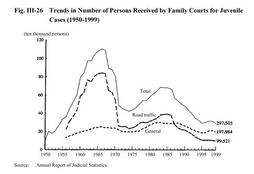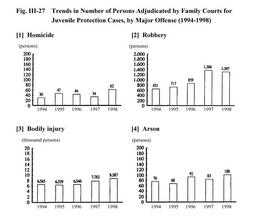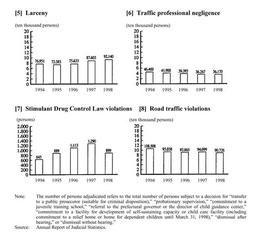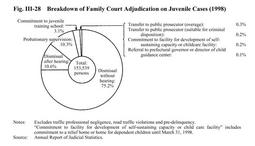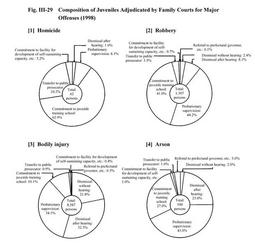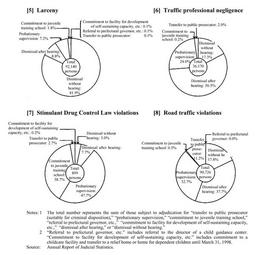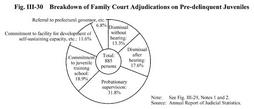| Previous Next Index Image Index Year Selection | |
|
|
2 Adjudication of juveniles Fig. III-26 shows the number of persons received by family court for juvenile cases since 1950. Trends are also shown separately for general cases and road traffic cases(juvenile cases related to road traffic violations).
Fig. III-26 Trends in Number of Persons Received by Family Courts for Juvenile Cases(1950-1999) The total number received decreased after peaking at 1,094,339 in 1966, but started to increase in 1975 to reach the next peak in 1983 at 684,830, followed by a decline until 1995. It continued to rise from 1996, only to decline by 21,003(6.6%) from the previous year in 1999 to 297,505.The number received for general cases, after reaching a record high of 302,856 in 1983, stayed on a par or showed a downward trend until 1995. It continued to increase from 1996 but fell by 15,647(7.3%) from the previous year in 1999 to 197,984. The number received for road traffic cases exceeded the number received for general cases until 1986. It dropped, however, from 1987, when the scope of the traffic infraction notification system was expanded. It has been declining since recording increases in 1996 and 1997. The number stood at 99,521 in 1999, down 5,356(5.1%) from the previous year. Fig. III-27 shows the number of persons adjudicated by family courts in the five-year period from 1994 through 1998, by major offense. The number of juveniles adjudicated for homicide almost doubled in 1988 to reach 62, after recording fluctuations repeatedly. The number for robbery continued to increase until 1997, when it shot up to reach a figure more than twice as large as that recorded in 1994. It declined slightly from the previous year in 1998. The numbers for bodily injury and larceny have both continued to increase, with the exception of a slight decline recorded in 1995. The number for arson has shown an upward trend, with some fluctuations. The number for traffic professional negligence has declined constantly. The number for Stimulant Drug Control Law violations almost doubled between 1994 and 1997, only to resume the level of 1995 in 1998, recording a substantial drop. The number for road traffic violations has continued to decrease with the exception of 1997. Fig. III-27 Trends in Number of Persons Adjudicated by Family Courts for Juvenile Protection Cases, by Major Offense(1994-1998) Fig. III-28 shows details of the adjudications of family courts in1998for juvenile protection cases other than those involving traffic professional negligence, road traffic viollations and pre-delinquency.Fig. III-28 Breakdown of Family Court Adjudication on Juvenile Cases(1998) By offense, larceny had the largest share(60.1%)in the number of juveniles adjudicated by family courts, followed by embezzlement including embezzlement of lost property(21.1%), bodily injury(5.6%), extortion(3.5%)and Poisonous and Deleterious Substances Control Law violations(2.2%)(see Appendix III-11 ).Fig. III-29 shows details of family court adjudications on juvenile cases in1998for major offenses. More than half of the cases involving bodily injury, larceny, traffic professional negligence or road traffic violations resulted in dismissal after or without a hearing. As regards homicide, robbery, arson and Stimulant Drug Control Law violations, more than70%of cases resulted in protective measures such as probationary supervision or commitment to a juvenile training school. The ratio of transfer to a public prosecutor amounted to24.2%for homicide and11.2%for road traffic violations but remained below5%for robbery, arson, traffic professional negligence and Stimulant Drug Control Law violations, and was less than1%for bodily injury and larceny. Fig. III-29 Composition of Juveniles Adjudicated by Family Courts for Major Offenses(1998) Fig. III-30 shows details of family court adjudications on pre-delinquent juveniles in1998. The ratio of protective measures such as probationary supervision and commitment to a juvenile training school was higher than in juvenile protection cases excluding traffic professional negligence, road traffic violations and pre-delinquency.Fig. III-30 Breakdown of Family Court Adjudications on Pre-delinquent Juveniles |
